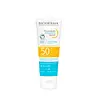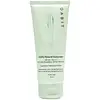What's inside
What's inside
 Key Ingredients
Key Ingredients

 Benefits
Benefits

 Concerns
Concerns

 Ingredients Side-by-side
Ingredients Side-by-side

Water
Skin ConditioningCaprylic/Capric Triglyceride
MaskingZinc Oxide
Cosmetic ColorantC15-19 Alkane
SolventTitanium Dioxide
Cosmetic ColorantPolyglyceryl-3 Ricinoleate
EmulsifyingSorbitan Isostearate
EmulsifyingSilica
AbrasiveDicaprylyl Carbonate
EmollientGlyceryl Isostearate
EmollientPentylene Glycol
Skin ConditioningPrunus Armeniaca Kernel Oil
MaskingPolyhydroxystearic Acid
EmulsifyingTocopherol
AntioxidantSodium Chloride
MaskingSodium Citrate
BufferingStearalkonium Hectorite
Gel FormingGlycine Soja Oil
EmollientPropylene Carbonate
SolventCitric Acid
BufferingWater, Caprylic/Capric Triglyceride, Zinc Oxide, C15-19 Alkane, Titanium Dioxide, Polyglyceryl-3 Ricinoleate, Sorbitan Isostearate, Silica, Dicaprylyl Carbonate, Glyceryl Isostearate, Pentylene Glycol, Prunus Armeniaca Kernel Oil, Polyhydroxystearic Acid, Tocopherol, Sodium Chloride, Sodium Citrate, Stearalkonium Hectorite, Glycine Soja Oil, Propylene Carbonate, Citric Acid
Water
Skin ConditioningZinc Oxide
Cosmetic ColorantC15-19 Alkane
SolventIsocetyl Stearoyl Stearate
EmollientHydrogenated Polydecene
EmollientSilica
AbrasiveDiisooctyl Succinate
EmollientHydrogenated Soy Polyglycerides
Skin ConditioningOctyldodecanol
EmollientPolyglyceryl-6 Polyhydroxystearate
EmulsifyingPolyglyceryl-6 Polyricinoleate
EmulsifyingGlycerin
HumectantPolyhydroxystearic Acid
EmulsifyingPropylene Carbonate
SolventDisteardimonium Hectorite
StabilisingIsododecane
EmollientCrocus Sativus Flower Extract
MaskingMagnesium Sulfate
Sodium Chloride
MaskingXanthan Gum
EmulsifyingCetyl Alcohol
EmollientWithania Somnifera Root Extract
Skin ConditioningHydroxyacetophenone
AntioxidantC15-23 Alkane
SolventPhysalis Angulata Extract
Skin ProtectingTrisodium Ethylenediamine Disuccinate
Caprylic/Capric Triglyceride
MaskingDimethylmethoxy Chromanol
AntioxidantLactobacillus Ferment Lysate
Skin ConditioningAvena Sativa Meristem Cell Extract
HumectantAvena Sativa Sprout Oil
Skin ConditioningTocopherol
AntioxidantWater, Zinc Oxide, C15-19 Alkane, Isocetyl Stearoyl Stearate, Hydrogenated Polydecene, Silica, Diisooctyl Succinate, Hydrogenated Soy Polyglycerides, Octyldodecanol, Polyglyceryl-6 Polyhydroxystearate, Polyglyceryl-6 Polyricinoleate, Glycerin, Polyhydroxystearic Acid, Propylene Carbonate, Disteardimonium Hectorite, Isododecane, Crocus Sativus Flower Extract, Magnesium Sulfate, Sodium Chloride, Xanthan Gum, Cetyl Alcohol, Withania Somnifera Root Extract, Hydroxyacetophenone, C15-23 Alkane, Physalis Angulata Extract, Trisodium Ethylenediamine Disuccinate, Caprylic/Capric Triglyceride, Dimethylmethoxy Chromanol, Lactobacillus Ferment Lysate, Avena Sativa Meristem Cell Extract, Avena Sativa Sprout Oil, Tocopherol
Ingredients Explained
These ingredients are found in both products.
Ingredients higher up in an ingredient list are typically present in a larger amount.
C15-19 alkane is a mixture of alkanes. Alkanes are hydrocarbons with carbon atoms held together by single bonds.
It is a synthetically created solvent and emollient often used to replace silicones or mineral oil. As an emollient, C15-19 Alkane helps soften and soothe the skin. Emollients create a barrier to trap moisture inside.
C15-19 Alkane is often used with mineral UV filters such as titanium dioxidide and zinc oxide. It helps these UV filter ingredients be more spreadable.
C15-19 Alkane is biodegradable.
Learn more about C15-19 AlkaneThis ingredient is an emollient, solvent, and texture enhancer. It is considered a skin-softener by helping the skin prevent moisture loss.
It helps thicken a product's formula and makes it easier to spread by dissolving clumping compounds.
Caprylic Triglyceride is made by combining glycerin with coconut oil, forming a clear liquid.
While there is an assumption Caprylic Triglyceride can clog pores due to it being derived from coconut oil, there is no research supporting this.
Learn more about Caprylic/Capric TriglyceridePolyhydroxystearic Acid is a soft wax made from castor oil.
It is is a texture thickener, emulsifier, and film-former. Emulsifiers prevent ingredients from separating, such as oils and waters.
Polyhydroxystearic Acid may not be fungal acne safe.
Learn more about Polyhydroxystearic AcidThis ingredient is a solvent. It helps dissolve active ingredients and alter the texture of products.
Propylene Carbonate is commonly used in makeup and with clay, such as montmorillonite or bentonite.
Studies show this ingredient to be safe for cosmetics. When it is undiluted, it can cause skin irritation. (It is always diluted in skincare and makeup). This ingredient is water-soluble.
Propylene Carbonate is created from propylene glycol and carbonic acid.
Learn more about Propylene CarbonateSilica, also known as silicon dioxide, is a naturally occurring mineral. It is used as a fine, spherical, and porous powder in cosmetics.
Though it has exfoliant properties, the function of silica varies depending on the product.
The unique structure of silica enhances the spreadability and adds smoothness, making it a great texture enhancer.
It is also used as an active carrier, emulsifier, and mattifier due to its ability to absorb excess oil.
In some products, tiny microneedles called spicules are made from silica or hydrolyzed sponge. When you rub them in, they lightly polish away dead skin layers and enhance the penetration of active ingredients.
Learn more about SilicaChances are, you eat sodium chloride every day. Sodium Chloride is also known as table salt.
This ingredient has many purposes in skincare: thickener, emulsifier, and exfoliator.
You'll most likely find this ingredient in cleansers where it is used to create a gel-like texture. As an emulsifier, it also prevents ingredients from separating.
There is much debate on whether this ingredient is comedogenic. The short answer - comedogenic ratings don't tell the whole story. Learn more about comegodenic ratings here.
The concensus about this ingredient causing acne seems to be divided. Research is needed to understand if this ingredient does cause acne.
Scrubs may use salt as the primary exfoliating ingredient.
Learn more about Sodium ChlorideTocopherol (also known as Vitamin E) is a common antioxidant used to help protect the skin from free-radicals and strengthen the skin barrier. It's also fat soluble - this means our skin is great at absorbing it.
Vitamin E also helps keep your natural skin lipids healthy. Your lipid skin barrier naturally consists of lipids, ceramides, and fatty acids. Vitamin E offers extra protection for your skin’s lipid barrier, keeping your skin healthy and nourished.
Another benefit is a bit of UV protection. Vitamin E helps reduce the damage caused by UVB rays. (It should not replace your sunscreen). Combining it with Vitamin C can decrease sunburned cells and hyperpigmentation after UV exposure.
You might have noticed Vitamin E + C often paired together. This is because it is great at stabilizing Vitamin C. Using the two together helps increase the effectiveness of both ingredients.
There are often claims that Vitamin E can reduce/prevent scarring, but these claims haven't been confirmed by scientific research.
Learn more about TocopherolWater. It's the most common cosmetic ingredient of all. You'll usually see it at the top of ingredient lists, meaning that it makes up the largest part of the product.
So why is it so popular? Water most often acts as a solvent - this means that it helps dissolve other ingredients into the formulation.
You'll also recognize water as that liquid we all need to stay alive. If you see this, drink a glass of water. Stay hydrated!
Learn more about WaterZinc Oxide is a mineral broad-spectrum UV filter; it is the broadest UVA and UVB reflector approved by the FDA. It also has skin protectant and skin soothing properties.
Zinc oxide is one of the most effective broad-spectrum UV filters. It protects against UVB, UVAII, and UVAI. In comparison to its counterpart titanium dioxide, zinc oxide provides uniform and extended UVA protection.
Another great benefit? This ingredient is highly photostable so it won't degrade easily under sunlight.
A common myth is that mineral UV filters are widely believed to primarily reflect UV light.
However, modern research shows titanium dioxide absorbs UV radiation like chemical filters (~95% absorption & 5% reflection).
Zinc oxide has great skin soothing properties so you'll likely find this in sunscreens formulated for sensitive skin or babies/children. It is unlikely to cause "eye sting" like other sunscreen ingredients.
Regulatory agencies consider zinc oxide to be non-toxic and safe. It has also been shown to not penetrate the skin.
Unfortunately, this ingredient does leave a visible white cast. This is why mineral sunscreens are often less cosmetically elegant than chemical or hybrid ones.
In cosmetics, zinc oxide can be found in both non-nano and nano-sized forms. The nano version is used to reduce white cast and improve the texture of sunscreen formulas.
There are ongoing concerns surrounding nano-zinc oxide's impact on marine ecosystems and whether it can be absorbed into skin.
Regarding marine ecosystems and coral reefs, there is no conclusive evidence that any form of zinc oxide (or any other sunscreen ingredients) will cause harm. The science is still developing but many consumers are keeping a close eye on this issue.
Please note, many destinations have reef-safety sunscreen rules. For instance, the U.S. Virgin Islands advises all visitors to use non-nano mineral sunscreens.
There has also been some stir about whether micronized or nano zinc oxide has potential photoxicity and absorption through the skin/lungs.
An in-vitro (done in a test tube or petri dish) study demonstrated micronized zinc oxide to have potential phototoxicity. There's no need to fret; the EU Commission's Scientific Committee on Consumer Safety has stated, "The relevance of these findings needs to be clarified by appropriate investigations in vivo." Or in other words, further studies done on living organisms are needed to prove this.
Current research shows zinc oxide nanoparticles do not penetrate intact or sunburned skin. They either remain on the surface or in the outermost layer of dead skin (stratum corneum).
Zinc oxide is one of only two classified mineral UV filters with titanium dioxide being the other one.
Fun fact: Zinc has been used throughout history as an ingredient in paint and medicine. An Indian text from 500BC is believed to list zinc oxide as a salve for open wound. The Ancient Greek physician Dioscorides has also mentioned the use of zinc as an ointment in 1AD.
Learn more about Zinc Oxide